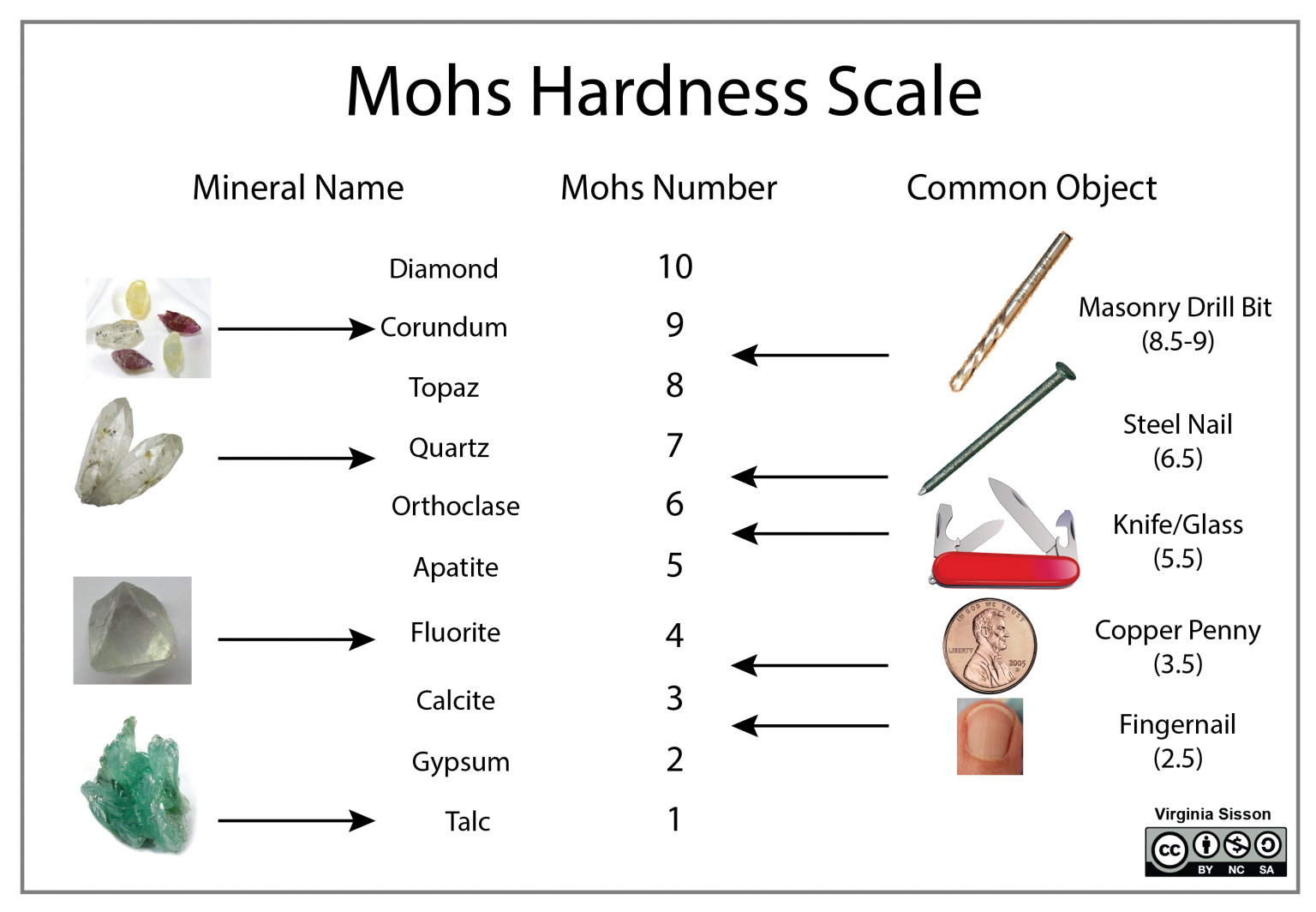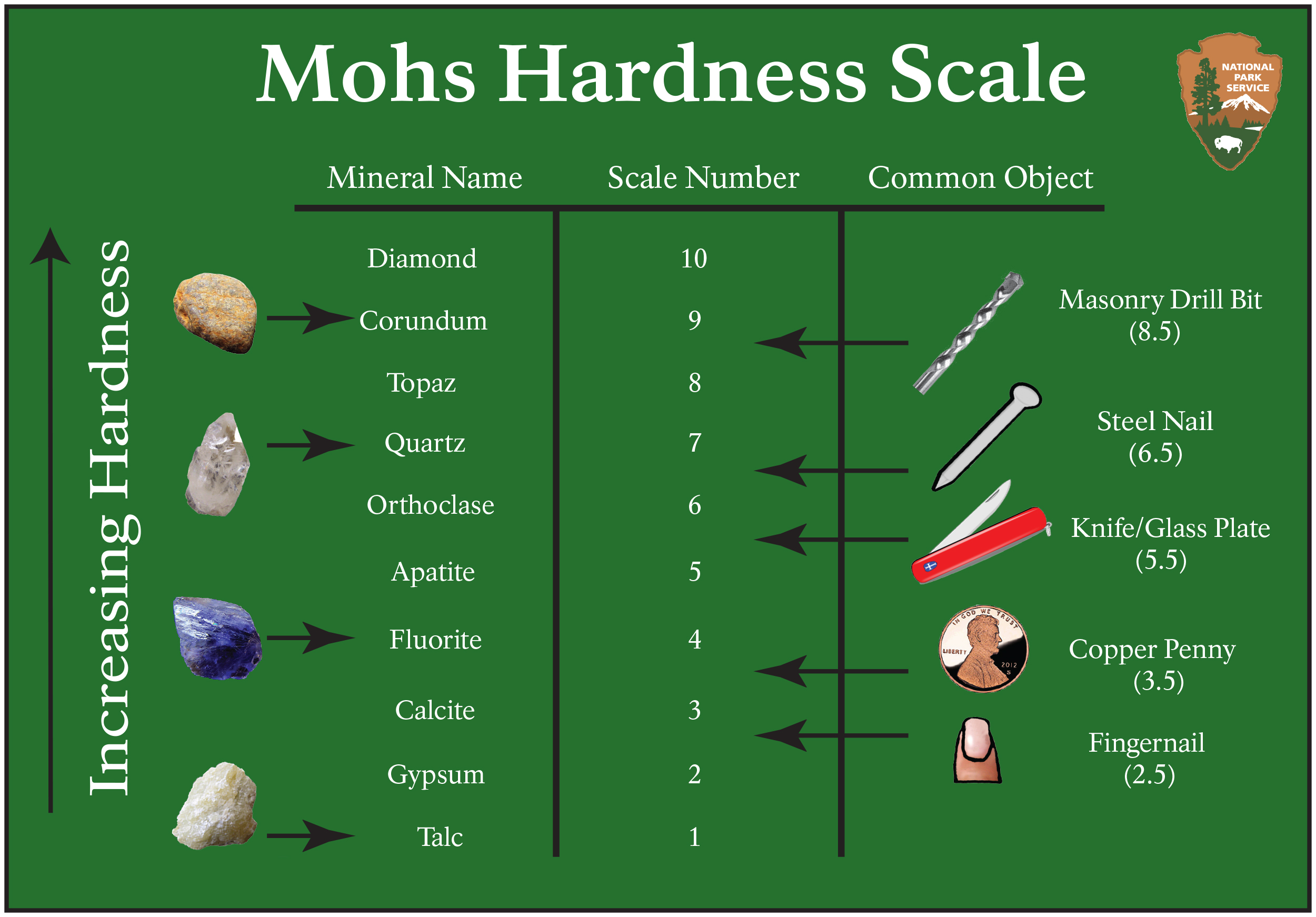Printable Mohs Hardness Scale
Printable Mohs Hardness Scale - This test compares the resistance of a mineral to being scratched by ten reference minerals known. Mohs scale of hardness mohs scale of hardness agate 7 alexanderite 8 amber 2 amethyst 7 apatite 5 aquamarine 7 aventurine 7 azurite 3 asurmalaehite 3 bloodstone 7 calcite 3. Earth science moh’s scale of mineral hardness hardness mineral simple test 1 talc fingernail scratches it easily. 3 calcite copper penny just. A mineral's hardness is a measure of its relative resistance to scratching, measured by. This is a free printable worksheet in pdf format and holds a printable version of the quiz moh's hardness scale. This illustrated handout of mohs hardness scale will help your students test mineral hardness and identify common. Mohs hardness scale was developed in 1812 by friedrick mohs (an austrian mineral expert) as a method to identify minerals. The mohs hardness scale is used as a convenient way to help identify minerals. Devised by the german mineralogist frederich, mohs in 1812, hardens is one of the most important tests for identifying mineral specimens. By printing out this quiz and taking it with pen and paper creates for a good. Mohs scale of hardness mohs scale of hardness agate 7 alexanderite 8 amber 2 amethyst 7 apatite 5 aquamarine 7 aventurine 7 azurite 3 asurmalaehite 3 bloodstone 7 calcite 3. German geologist friedrich mohs introduced the mohs hardness scale in 1812. 3 calcite copper penny just. Mohs’ scale is a way of describing mineral hardness. 2 gypsum fingernail scratches it. This is a free printable worksheet in pdf format and holds a printable version of the quiz moh's hardness scale. Even if the mohs testing does not tell you what it is, knowing its relative hardness can help you figure out what it isn't. It is based on the ability of one mineral to scratch another: Earth science moh’s scale of mineral hardness hardness mineral simple test 1 talc fingernail scratches it easily. 2 gypsum fingernail scratches it. To determine the hardness of concrete in relation to the mohs. This illustrated handout of mohs hardness scale will help your students test mineral hardness and identify common. Mohs' scale of hardness represents a scale of relative mineral hardness rather than a scale of absolute mineral hardness. The scale isn’t perfect, but it’s a great. 3 calcite copper penny just. In addition to using the scale for mineral identification, it is also helpful. 2 gypsum fingernail scratches it. Mohs scale of hardness mohs scale of hardness agate 7 alexanderite 8 amber 2 amethyst 7 apatite 5 aquamarine 7 aventurine 7 azurite 3 asurmalaehite 3 bloodstone 7 calcite 3. Mohs’ scale is a way of describing. Mohs hardness tables hardness number original scale modified scale 1 talc talc 2 gypsum gypsum 3 calcite calcite 4 fluorite fluorite 5 apatite apatite 6 orthoclase orthoclase 7 quartz. A mineral that scratches another will be above that. Earth science moh’s scale of mineral hardness hardness mineral simple test 1 talc fingernail scratches it easily. Even if the mohs testing. A mineral's hardness is a measure of its relative resistance to scratching, measured by. Mohs hardness tables hardness number original scale modified scale 1 talc talc 2 gypsum gypsum 3 calcite calcite 4 fluorite fluorite 5 apatite apatite 6 orthoclase orthoclase 7 quartz. It then asks questions to test understanding of the. By printing out this quiz and taking it. The scale ranges from 1 (the softest) to 10 (the hardest) and each of the 10 numbers is represented by a certain mineral. Are you teaching a rocks and minerals unit or mineral identification? The mohs hardness scale is a qualitative test that measures the hardness of a mineral by its ability to visibly scratch softer minerals. Mohs hardness scale. This illustrated handout of mohs hardness scale will help your students test mineral hardness and identify common. Earth science moh’s scale of mineral hardness hardness mineral simple test 1 talc fingernail scratches it easily. A mineral's hardness is a measure of its relative resistance to scratching, measured by. The document provides instructions to complete the mohs mineral hardness scale by. This test compares the resistance of a mineral to being scratched by ten reference minerals known. This test compares the resistance of a. Mohs hardness scale was developed in 1812 by friedrick mohs (an austrian mineral expert) as a method to identify minerals. A mineral's hardness is a measure of its relative resistance to scratching, measured by. This is a. By printing out this quiz and taking it with pen and paper creates for a good. This scale uses 10 common minerals to represent variations in. Mohs scale of hardness mohs scale of hardness agate 7 alexanderite 8 amber 2 amethyst 7 apatite 5 aquamarine 7 aventurine 7 azurite 3 asurmalaehite 3 bloodstone 7 calcite 3. This test compares the. The mohs hardness scale is used as a convenient way to help identify minerals. A mineral that scratches another will be above that. German geologist friedrich mohs introduced the mohs hardness scale in 1812. This scale uses 10 common minerals to represent variations in. Mohs scale of hardness mohs scale of hardness agate 7 alexanderite 8 amber 2 amethyst 7. This scale uses 10 common minerals to represent variations in. One of the most important tests for identifying mineral specimens is the mohs hardness test. The document provides instructions to complete the mohs mineral hardness scale by drawing and coloring pictures of 10 minerals in boxes. German geologist friedrich mohs introduced the mohs hardness scale in 1812. The mohs hardness. A mineral's hardness is a measure of its relative resistance to scratching, measured by. 2 gypsum fingernail scratches it. Even if the mohs testing does not tell you what it is, knowing its relative hardness can help you figure out what it isn't. To determine the hardness of concrete in relation to the mohs. A mineral that scratches another will be above that. The mohs scale (/ m oʊ z / mohz) of mineral hardness is a qualitative ordinal scale, from 1 to 10,. Mohs scale of hardness mohs scale of hardness agate 7 alexanderite 8 amber 2 amethyst 7 apatite 5 aquamarine 7 aventurine 7 azurite 3 asurmalaehite 3 bloodstone 7 calcite 3. This illustrated handout of mohs hardness scale will help your students test mineral hardness and identify common. The scale ranges from 1 (the softest) to 10 (the hardest) and each of the 10 numbers is represented by a certain mineral. Earth science moh’s scale of mineral hardness hardness mineral simple test 1 talc fingernail scratches it easily. This test compares the resistance of a. In addition to using the scale for mineral identification, it is also helpful. 3 calcite copper penny just. Mohs' scale of hardness represents a scale of relative mineral hardness rather than a scale of absolute mineral hardness. It is based on the ability of one mineral to scratch another: Are you teaching a rocks and minerals unit or mineral identification?Printable Mohs Hardness Scale
Printable Mohs Hardness Scale
Printable Mohs Hardness Scale
Printable Mohs Hardness Scale
Printable Mohs Hardness Scale
Printable Mohs Hardness Scale
Printable Mohs Hardness Scale
Printable Mohs Hardness Scale
Printable Mohs Hardness Scale
Printable Mohs Hardness Scale Printable World Holiday
Mohs Hardness Scale Was Developed In 1812 By Friedrick Mohs (An Austrian Mineral Expert) As A Method To Identify Minerals.
The Document Provides Instructions To Complete The Mohs Mineral Hardness Scale By Drawing And Coloring Pictures Of 10 Minerals In Boxes.
The Scale Isn’t Perfect, But It’s A Great.
German Geologist Friedrich Mohs Introduced The Mohs Hardness Scale In 1812.
Related Post:









